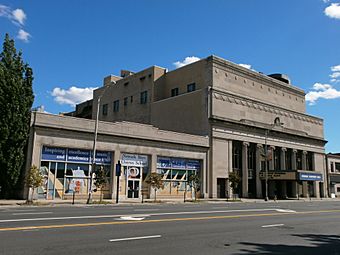Newark Symphony Hall facts for kids
 |
|
| Address | 1020 Broad Street Newark, New Jersey United States |
|---|---|
| Owner | Essex County Improvement Authority |
| Type | Performing arts center |
| Capacity | Sarah Vaughan Hall: 3,500 Newark Stage: 200 |
| Construction | |
| Opened | 1925 |
| Architect | Grad Associates |
|
Salaam Temple
|
|

Symphony Hall and Boys Chorus School
|
|
| Location | 1020 Broad Street, Newark, New Jersey, U.S. |
|---|---|
| Area | 1.0566 acres (0.4276 ha) |
| Built | 1925 |
| Architect | Grad Associates |
| Architectural style | Classical Revival |
| NRHP reference No. | 77000867 |
| Added to NRHP | October 5, 1977 |
Newark Symphony Hall is a famous place for shows and concerts in Newark, New Jersey. It opened in 1925 and was added to a list of important historic places in 1977. For many years, people knew it as The Mosque Theater. It used to be the home for groups like the New Jersey Symphony Orchestra and the New Jersey Ballet Company.
The Essex County Improvement Authority owns the Hall. A group called Newark Performing Arts Corporation (NPAC) runs it.
Building and Design
The building was first built in 1925 by a group called the Shriners. It cost over $2 million and was called Salaam Temple. People often called it The Mosque. Since 1964, it has been known as Newark Symphony Hall.
The inside of the building is very fancy. It has designs from ancient Greece and Egypt. You can see marble columns, a big crystal chandelier, and gold decorations. The building was designed by Frank Grad, a well-known architect from Newark.
The main concert hall has 3,500 seats and is named after Sarah Vaughan. She was a famous singer from Newark. This hall is known for its amazing sound quality.
Newark Symphony Hall also has other spaces:
- Newark Stage: A smaller theater with 200 seats, used for plays.
- The Terrace Ballroom: A large room used for parties and events.
- The Studio: A space for rehearsals.
- The Dance Studio: This is one of only three places in New Jersey used by the School of the Garden State Ballet, a dance school started in 1951.
History of the Hall
In its early years, the theater received support from the Griffith Piano Company. This company also built the Griffith Building, which was used for showing pianos and holding concerts.
In 1940, Marian Anderson, a famous African American singer, performed at the symphony hall. She was the first African American to do so.
New Jersey's first TV station, WATV Channel 13, started broadcasting from studios inside The Mosque Theater on May 15, 1948. Other radio stations also had their studios there. Today, Channel 13 is a non-commercial station called WNET.
In 1964, The Mosque Theater was having money problems and was almost torn down. A famous concert organizer named Sol Hurok said it would be a "terrible misfortune" to lose it because it was such a great concert hall. The city bought it for $340,000, and it became a non-profit organization. That's when it was renamed Symphony Hall.
Many famous performers have appeared at Symphony Hall. These include opera stars like the Metropolitan Opera, Jerome Hines, and Leontyne Price.
Other well-known artists who have performed there include Victor Borge, Judy Garland, Bob Dylan, The Supremes, Patti LaBelle, The Rolling Stones, and Eric Clapton.
Before the New Jersey Performing Arts Center opened, Symphony Hall was one of the main places for performances in New Jersey. It was home to the New Jersey Symphony and the New Jersey State Opera. Even now, Symphony Hall continues to host plays, music, and dance shows. Many community groups have held their annual events there for over 25 years.
The area around the Hall is known as The Coast. This part of Newark has a rich history of producing gospel music and many famous Black artists.
Newark Symphony Hall is home to Special Ensemble, a group that won the McDonald's Gospelfest. The Hall also hosts an annual gospel music show called "When Praise Goes Up!"
In 2007, there was a plan to create a Museum of African American Music at the Hall. This museum would collect information about different types of music like jazz, blues, hip-hop, and gospel.
In 2009, the Hall announced a plan to raise $40 million to fix up the theater. Restoration work continued in January 2020, with plans to finish by the building's 100th anniversary in 2025. In October 2020, the Hall received a large grant to help fund its renovation.
In April 2021, while the Hall was closed due to the Coronavirus pandemic, it started hosting online events. It also launched "The Lab," a program to help local performing artists. In May 2021, the renovation budget increased to $50 million. Plans included restoring the original sign, adding a new plaza, and reopening a floor that had been empty for 30 years.
In November 2018, Taneshia Nash Laird became the new President and CEO of NPAC, the company that runs the Hall. In December 2019, the Hall held auditions for a TV show about the history of Uptown Records.
How it Works
The non-profit Newark Performing Arts Corporation (NPAC) runs Newark Symphony Hall. The Hall's yearly budget is about $1.7 million, with the city of Newark contributing $600,000. The Hall is listed on historic registers, which helps it get special funding for its upkeep. Talia Young is the current CEO and President of NPAC.
See also
- The Coast
- Stanley Theater (Newark, New Jersey)
- National Register of Historic Places listings in Essex County, New Jersey




